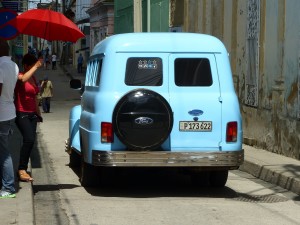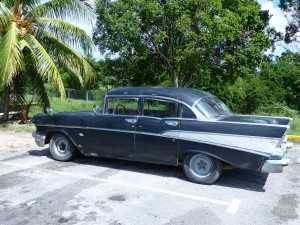You may (or may not) know much about Cuba, that mystical little island that sits about 90 miles off the south coast of Miami. You probably do know about the world’s appetite for the finest Cuban cigars and rum, the latter being the primary ingredient of the perfect Mojito. Maybe you’ve heard that president Obama began easing U.S. trade and travel restrictions with Cuba a few years back. If you’re a little older you may remember the Russian/Cuban Missile Crises, or the ill-fated Bay of Pigs invasion. And you probably heard that Cuba’s 90 year-old revolutionary dictatorial leader, Fidel Castro, recently passed away. In its heyday, Cuba was nicknamed the “Paris of the Caribbean,” and played host to the rich and famous, the Rat Pack, the mafia, several heavyweight boxing bouts and wealthy vacationers from around the world: an irresistible combination of waterfront hotels, gambling, sunny beaches, rum and cigars.
I have long heard of the crazy car scene down there, where old American cars are held together with bailing wire, tape, and tractor parts, or whatever the resourceful Cuban car enthusiasts can get their hands on in order to keep their cars on the road. I had visions of brightly colored American ragtops, filled with tanned, attractive, Cuban women cruising up and down the waterfront. I’m here to tell you, brother, that it’s all true. American cars used to be freely imported into and sold in Cuba, prior to the United States’ trade embargo beginning in 1959 – this was the American Government’s way of protesting the Cuban Revolution, Communism, and the reign of the Castro family. The last new American cars to legally make it to the island were 1959 and 1960 models. I had to see it for myself, so wife Linda and I went in late 2016, just prior to Fidel’s passing.
Experts estimate that 50-60,000 pre-1960 classic American cars are marooned on the island, as no new American cars are currently being sold there, and it is illegal to export vintage tin off the island for two reasons. The first is that they are now considered national treasures, part of Cuba’s color and history. Secondly, it would be detrimental to the locals who depend on these cars as a means of transportation and often income. Many other countries have free trade with Cuba, so most of the new cars you see are Russian, Italian (primarily Fiat), German, Korean, and Japanese. Any post-1960 American car or truck made it to Cuba via one of several black markets.

Talk about a “vroom with a view” cruising Cuba in the back seat of a 50s American convert is the only way to fly.

Some of the cars are rode hard and never put away. This Imperial Crown Coupe has certainly seen better days, but still on the road, and For Sale too…so could be yours.
On the plane ride from LA to Miami, I was wondering how long I’d have to wait, or how far I’d have to walk, so see cool cars out prowling the island. The answer turned out to be “30-30” that being 30 feet or 30 seconds, whichever came first. I cleared customs and walked out of the charming little airport in Santa Clara (just a few hours outside of Havana) to a parking lot about the size of a baseball diamond, and my camera combusted spontaneously: ’57 Chevys, a couple ’55-56 Fords, a few American trucks, and the absolute most battle-worn ’59 Chrysler Imperial Crown Coupe I’ve seen this side of a wrecking yard.
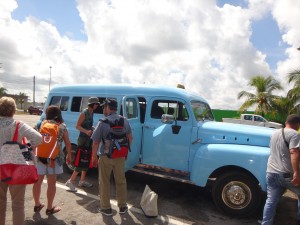
Meeting my ride for the week, loading up the Blue Whale at the airport. A sight for car hungry eyes.

This gives you an idea of how much length Frank and his building buddies added to this ’48 Ford Panel. Now the perfect 10 passenger tour bus.
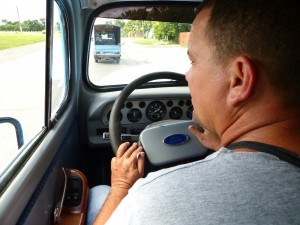
Frank at the wheel of his Blue Whale. Note updated instruments and wheel. Besides being a very nice guy, Frank was a smooth smart driver; I’d let him drive me anywhere.

No wheezy old flathead in here; the Blue Whale’s entire chassis and powertrain updated by Frank and his build team; this is a naturally aspirated four-cylinder Toyota diesel engine, handily mated to a Nissan 5-speed truck transmission.
And it was in this airport lot that I met up with my tour bus driver for the week, Frank. Frank is a tough but friendly local who has been driving taxi for 25 years, and Frank owns, drives, and built, the Blue Whale. The Blue Whale began life as a standard 1948 Ford F-1 panel delivery, which worked its first career for a coffee delivery company. Over the decades, the “Ford, 48!” as Frank calls it, served well but just wore out. Frank picked it up as a tired, but generally complete, non-runner. No problem: Frank had plans. He and a couple buddies cut the old Ford into quarters if you were looking down from the top. They then widened it a little more than a foot, then lengthened it two feet. This major surgery greatly increased the track, comfort, ride quality, and interior dimensions – in the Cuba tour taxi biz, more seats means more income potential.
The frame needed serious expanding and reinforcing to match the newly enlarged bodywork. The guys re-engineered the whole undercarriage and beefed up the suspension. Frank wanted it stable and smooth, which meant dual rear wheels, like any current one-ton “dually” truck would have. So he found a Ford 9-inch rear end, narrowed it, then machined new hubs and axles set up for eight-lug duals out back. No stock powertrain would handle the gaff of up to 10 passengers plus luggage, so Frank and friends latched on to a Toyota four-cylinder diesel truck engine, then hand fabbed motor mounts and a bellhousing adaptor to mate it to a Nissan heavy-duty truck 5-speed, granny low, manual gearbox.

I nearly worked up the guts to ask Frank to let me drive the Blue Whale, but shotgun or second row seats was planty fine.
While the boys were at it, they plumbed it up for power steering, brakes, and AC. It took lots of time, money, and some serious sheet metal fortitude and parts scrounging, to fill in all the missing bodywork created by the lengthening and widening job, which Frank and pals did in his driveway. They also added an additional door on the passenger side, and comfy seats and sliding windows commandeered from a boneyard bus. The whole thing got a gray and blue upholstery job inside, and stainless steel trim and running boards out. Frank’s backyard also served as his spraybooth, and he and his pals finished it off in a mid-50s Ford non-metallic blue hue. The Blue Whale indeed. All in it was about a five year build, of mostly nights and weekends as all the guys have families and worked full time. Inside, the AC blows cold, the nav system keeps track, and you can watch DVDs if you want to, but I never did, as the colorful scenery passing by outside was entertainment enough for me. Frank keeps the Blue Whale immaculate at all times, and the big blue bus never overheated, ran warm, neither burped, farted, nor acted up in any way, no matter how many hours a day we ran it. If there’s a cooler way to cruise Cuba than this truck, I never saw it.

Linda and I truly came to love Frank – a tough but very nice man, who told us all about his family and life in Cuba.

As the days rolled by, I learned from Frank (and my American, multi-lingual tour director, also Matt) and observed that there are about four levels of cars plying Cuba’s sometimes great, more often crappy roads.
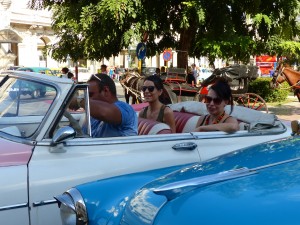
The perfect Tour Taxi scene — two lovely young touristas out for a top down tour of Havana in a great American ragtop.

Two young tour taxi dudes troll for fares in their brightly colored clothing and ’46 Ford convertible.
The top rung are very clean, handsome, nicely restified cars, mostly American convertibles of the 1950s; these are owned by the island’s most ardent enthusiasts and often serve as “tour taxis” down by Havana’s waterfront; plus cars just one level down, that may be converts or sedans. Then another similar layer of cars that don’t do taxi duty of any kind; private enthusiast owned cars.
Then finally a large community of still running semi–beaters that are either privately owned personal transport, or “route taxis” for locals to take to and from work.

Best place to pick up your favorite tour taxi is at this giant park parking lot across the street from the capitol building in Havana. Many of the cars are very fine.
I also discovered a bodystyle pecking order; the 50s era American convertible is king; next down from that is a coupe that’s been chopped into a convertible, which may or may not have a folding fabric top. The four door sedans and wagons are next, since they work well as taxis, and finally two door coupes and sedans are the least sought after; less room than the sedans and not as easy to hop in and out of on taxi runs. Expect to see nearly any American brand on the island:
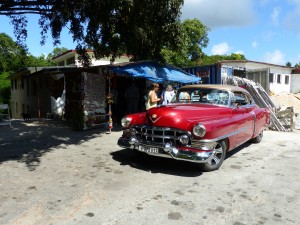
The Car of Kings is still the King of Cars in Cuba, like this ’53 Caddy we caught up with at Ernest Hemmingway’s fabulous Havana home.
Chevys and Fords are the most popular, Cadillacs and Lincolns are the kings of the hill, plus all of the other GMs like Buick, Olds, and Pontiac, and some Canadian GM and Ford (badged as Mercury) cars and trucks. Every once in a while, you’ll see an old Hudson, Kaiser, or Studebaker come grumbling by. Jeeps and particularly Jeepsters are very popular, as are early Toyota Land Cruisers. I swear that every 1947-1954 Plymouth sedan still running on earth is somewhere in Cuba; most in fair to shabby condition, running local worker taxi routes.

Check out the photobomber on the left; he’s Carlos, a crazy talkative Lebanese who retired to Cuba and built this fabulous ’55 Bel Air convert, replete with modern Hyundai turbodiesel power and manual transmission.

Look like fun? Trust me, its a hoot. Linda and I in the back, owner/driver Carlos snapping the photo, and my new BFF Dave in the front passenger seat.
You’ve likely heard that the parts supply down there varies from scarce to non-existant. While some Chinese made reproduction parts filter their way onto the island, you won’t likely find American made or factory replacement parts. You need an OEM rebuild kit for a 283? – forget it. This is one reason so many cars in Cuba boast crazy engine swaps. That and the fact that regular gasoline – at 83 Octane, no less – is about a buck a quart; diesel is cheaper and better quality. And diesel engines are plentiful; most tractors and industrial equipment run on diesel, as do many of the cars. One popular favorite is a Ssangyong inline 5-cylinder diesel – with turbo or without – that’s a near exact Korean copy of a similar Mercedes-Benz passenger I-5 oilburner. As noted, Frank’s Blue Whale ’48 Ford taxi bus runs a Toyota truck I-4 diesel with loads of torque, easy parts supply, and relatively good fuel mileage on the local diesel.
Now Carlos – a hyper Lebanese who retired to Cuba runs a Hyundai turbodiesel engine and 5-speed manual trans in his fabulously red and white ’55 Bel Air convertible, and swears it to be the best upgrade swap there is. He usually works the area around Cuba’s capitol building in Havana, and will take you on a one hour top down tour around all of the city’s hot spots – and talk your ear off in any of the six languages he speaks – for about $40. You can tell the cars that run modern turbodiesels, as they move along pretty briskly with minimal black smoke. Older, nat asp smokers are noisy and smelly, as you’d expect.

It’s old school with hand tools at NostalgicarCuba. These guys do the heavy lifting and the cars come out great.
Havana’s NostalgiCar survives two ways; the first is by buying and restoring cars which it then operates as classic tour taxis. Or the shop will restore customer cars; the shop owner has found enough black market channels by which to get parts without paying the usual 100% kickback premium, and is also good at fabricating or refubishing/recycling what they can’t buy new. NostalgiCar Cuba rarely performs diesel conversions any more; its restorations are highly authentic and beautifully done. These guys do the heavy metal work — old school cutting, patching, and replacing as opposed to troweling on the Bondo. Their cars look and run great. President and First Lady Obama visited this shop during their tour of Cuba early last year.

NostalgicarCuba principle Julio Torres is proud of his shop’s work, he’s also smart, passionate about cars, and hard working.
Owner Julio Torres also advises that cars like the big blue ’58 Bel Air hardtop sedan he just finished restoring, are more popular with six-cylinder engines than with V-8s. The I-6s are easier to rebuild, require less parts, and run better on the poor quality gas they have on the island.
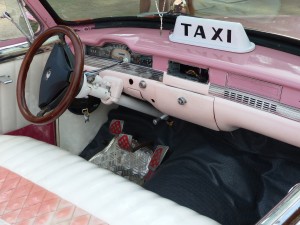
Check out the Plymouth’s Alfa Romeo steering wheel and column. Necessity is the mother of invention in Cuba Car Culture.
We did spot a few well restored classics still running authentic engines such as one intensely pink ’54 Plymouth ragtop still powered by its rebuilt, original flathead six. One ’57 Ford we checked out closely still ran a rumbling, healthy sounding Ford Y-block.

Presentation in post-flood temporary quarters is simple to say the least, but its all here: trucks, taxis, racers, bikes, vintage, a little bit of everything.
In the U.S. we are spoiled to have dozens if not hundreds of great museums and car collections to see; Cuba has one. It’s modest yet interesting. Just a week before my visit, Hurricane Matthew passed near Cuba, dropping torrential rains for several days, and the Museo Automovil was flooded, so the state-owned collection moved to a temporary warehouse location near old Havana. The cars were fine, although the current hopefully temporary display is simple, bereft of the dazzling museum craft we are used to at places like the Petersen Automotive Museum, the Henry Ford, Smithsonian and the others we can all name. Curator Eduardo was happy to get the collection’s modest archives out undamaged. No matter, the cars are cool.

I’m sure lots of Hogley-Davidson collectors in American would kill to have this lineup of early shifters.
Simple stuff, like Model Ts and Model As. A couple Alfa Romeos, one of them the only “Spider” model on the island. An ‘83 Malibu; a pair of Jags. A few 60s GM sedans, a Rolls-Royce, a Packard, and so forth. Plus a row of 40s and 50s stick-shift Harley-Davidsons that would surely find ready homes with American bike collectors.

Linda’s next husband, the tall, affable, rich, and most importantly uber friendly, Cuban born Chicago White Sox second baseman Jose Abreu.

My Team Cuba 2016, from left seated, Dave, behind him, lovely woman smiling with hat, Brenda Priddy, seated next to Dave is Michael, behind him is his sig other Ilene, then shaved head tour director Matt Smith, Linda seated, behind her our local Cuban Guide Alejandro, and fat American graybeard me. Drinks at sunset along the water at the famous Hotel Nacional.
The Cuban people are warm, wonderful, and appreciative of our interest in their historic country. You don’t see crime or drugs. The food is inexpensive and superb. The ocean is clean and the beaches pristine. The cars are colorful and interesting. And there is little better than cruising up and down the famous Malecon (the seawall which defines Havana’s ocean border, pronounced Mall-eh-cone) in an old American ragtop with the top down.
Senior – Uno mas Mojito por favor!
Special thanks: Brenda Priddy, Matt Smith, www.DetoursWithMatt.com, Alejandro, Frank.
Please don’t leave, lots more photos just below

Just in case you were wondering, yes — lots of pretty women on that wonderful little island called Cuba (in American, we tend to say Kyoobuh, but in Spanish, and locally, it’s “Koobuh.”

The whole transportation scene in Cuba is a hoot. The little thing on the right is a “Coco Cab” as it sort of resembles a coconut shell. This is a little plastic three person bench seat body that fits on the chassis of an old two-stroke scooter.
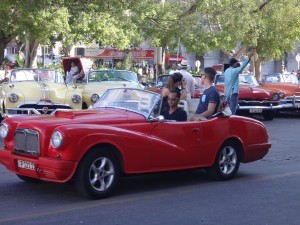
I have no idea what this is, but lots of these little fiberglass bodied neo classical or neo sports car looking kit things running loose in Cuba.

Wish this shot were in focus. This immaculate black ’59 hardtop sedan was a damn fine ride, diesel engine and all.

Transportation in Cienfuegos, Cuba is a habber scrabble mix of bikes, scooters, taxis, old cars, horses and whatever moves you.

This fabulous ’56 Ford Crown Victoria may be the car I saw on the island that I most wanted to bring home.
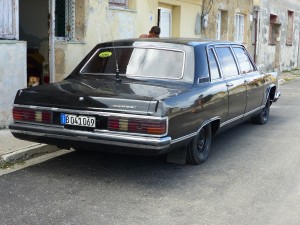
Now tell me this Russian Cold War era Chaika limo doesn’t look like a stretched and slightly overinflated Grand Marquis.

Petty rip and clip crime is not a big problem in Havana, but this Chaika owner/driver removes and reinstalls his rearview mirrors and hubcaps every day.

How long do you have to wait to see old American classics on the street? Just about a tenth of a second. Or less.

My beloved Blue Whale stops at the beach at the end of a long hard working for a well deserved cool down and a Mojito.
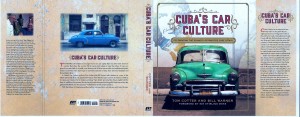
And if you want a great new book on the car scene in Cuba — now and back in the day — check out Cuba’s Car Culture, by my friends Tom Cotter and Bill Warner.





